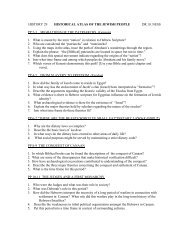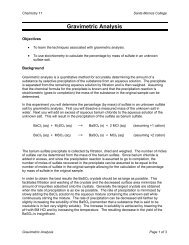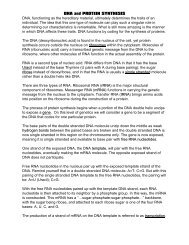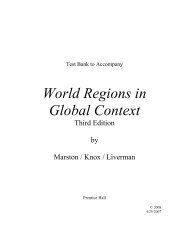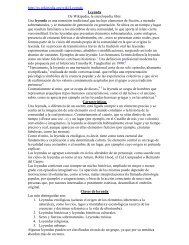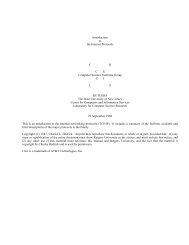You also want an ePaper? Increase the reach of your titles
YUMPU automatically turns print PDFs into web optimized ePapers that Google loves.
woman’s transit shoe of choice, flip-flops<br />
continue to reign. Believed to have been developed<br />
from traditional Japanese sandals,<br />
flip-flops can be made with a variety of materials,<br />
ranging from cheap rubber to leather,<br />
and may include various embellishments to<br />
dress them up. Flip-flops even made a publicized<br />
(albeit somewhat criticized) appearance<br />
at the White House in 2005, when some<br />
members of Northwestern University’s<br />
women’s lacrosse team wore them during<br />
their meeting with President Bush.<br />
Originally intended as a boating/outdoor<br />
shoe due to its slip-resistant, nonmarking sole,<br />
Crocs (produced by Crocs Inc.) became<br />
known by word of mouth for their comfort<br />
and lightweight design. The company, which<br />
holds four patents covering various aspects of<br />
its footwear, intends to transform itself into a<br />
lifestyle company based on two proprietary<br />
products: Croslite, a closed-cell, odor- and<br />
bacteria-resistant resin that molds to foot<br />
shape, for footwear, and Croslite rt, a lightweight,<br />
durable, and heat-resistant material,<br />
for apparel. Styles have been recommended for<br />
gardeners, nurses, and food service workers<br />
for comfort and have been popping up on the<br />
feet of men, women, and children. Sales in the<br />
first half of 2007 more than tripled over the<br />
same period in 2006, with 30% of sales from<br />
international markets. Sales for full-year 2007<br />
are expected to approach $1 billion. Whether<br />
Crocs turns out to be another footwear fad<br />
remains to be seen.<br />
Sports apparel goes upscale<br />
It is well understood that most athletic apparel<br />
and footwear is typically worn for<br />
nonathletic occasions, but the fashion industry<br />
is now partnering more frequently with<br />
traditional sports apparel companies. Perhaps<br />
one of the most visible moves in this<br />
area was the acquisition of a controlling interest<br />
in Puma AG Rudolf Dassler Sport in<br />
April 2007 by PPR SA (formerly Pinault-<br />
Printemps-Redoute). Designers Alexander<br />
McQueen and Philippe Starck are each<br />
working with Puma on different projects.<br />
Stella McCartney is working with Adidas AG<br />
for the fifth time, and Nike Inc. has partnered<br />
with John Varvatos.<br />
Sometimes the fashion industry incorporates<br />
textile and other innovations used in<br />
athletic apparel. In this realm, we are seeing<br />
fashionable clothing that has details like en-<br />
closed zippers and is made of material that<br />
wicks away sweat and fights bacteria. Fabrics<br />
with these elements have been available<br />
in sport clothing for some time.<br />
Specialty retailers follow shoppers to<br />
lifestyle centers<br />
Since 2000, mall growth has been stagnant,<br />
with only a handful of new openings to<br />
compensate for closings, so it is no wonder<br />
that retailers looking for growth are flocking<br />
to lifestyle centers. About half of the more<br />
than 150 lifestyle centers in the United States<br />
have opened since 2002, according to data<br />
from the International Council of Shopping<br />
Centers, a trade group.<br />
Lifestyle centers are upscale, outdoor<br />
shopping areas designed to look like an urban<br />
street and are typically located near affluent<br />
suburbs. Developers are finding it<br />
difficult to find large parcels of land for<br />
malls, and retailers find rental maintenance<br />
costs lower for lifestyle centers than at traditional<br />
malls. According to Poag & McEwan,<br />
the developers who first coined the term<br />
lifestyle centers, sales tend to be about $400<br />
to $500 per square foot in lifestyle centers,<br />
compared with $330 per square foot at traditional<br />
malls.<br />
The boom in luxury goods also may<br />
have played a role. Affluent shoppers seem<br />
to prefer a boutique-like atmosphere, which<br />
is very different from enclosed, 100,000square-foot<br />
malls anchored by a few department<br />
or discount stores. Often, tenants<br />
at lifestyle centers include stores from companies<br />
such as Banana Republic (owned by<br />
Gap), Coach Inc., Chico’s, and Pottery Barn<br />
(owned by Williams-Sonoma Inc.), as well<br />
as higher-end restaurants.<br />
Brands use “shop-in-shop” to grow<br />
In conjunction with opening their own<br />
stores, apparel and accessory brands have used<br />
shop-in-shop concepts to take more control of<br />
merchandising. In a shop-in-shop arrangement,<br />
floor space is dedicated to the display of products<br />
from one brand and typically includes special<br />
signage and fixtures. The proposition is<br />
attractive to both the manufacturer and the retailer<br />
in that the concepts help differentiate<br />
from competition; this allows the brand and<br />
the retailer to bring in higher-end merchandise<br />
and a broader selection, and cycle out slow<br />
NOVEMBER 29, 2007 / APPAREL & FOOTWEAR INDUSTRY SURVEY<br />
5



